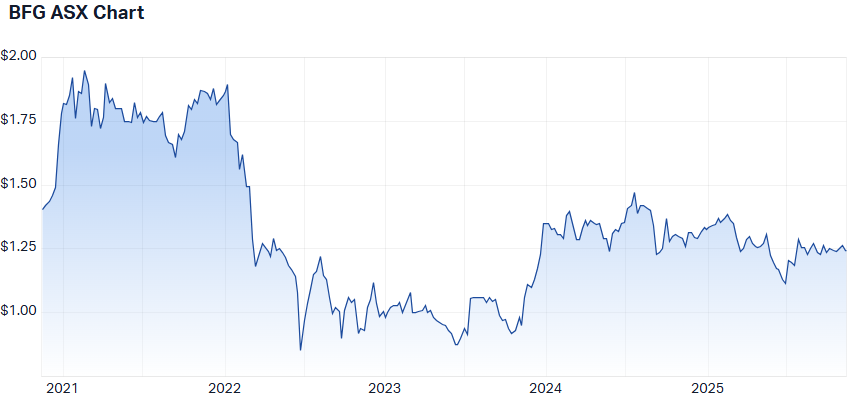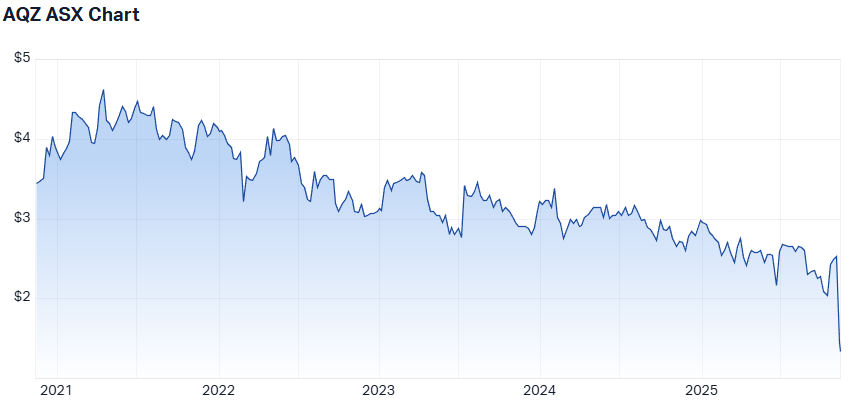Few firms use co-CEOs, yet one study says their share prices outperform by 40%
I recently listened to a Freakonomics podcast episode called "Are Two CEOs Better Than One?" It got me thinking… which ASX companies have Co-CEOs, and do they perform better?
That thought also made me reflect on my own workplace. Livewire is led by co-founders James Marlay and Tom McKay. With distinct but complementary strengths, they’ve built a business recognised multiple times on the AFR Fast 100 list.
For me, it’s a real-world example of how aligned leadership can deliver exceptional performance. It’s a dynamic that clearly works, and one that made the Freakonomics discussion hit closer to home.
Markets have long assumed the CEO role belongs to one person: one vision, one decision-maker, one leader. But this episode challenged that idea, arguing that dual leadership may be more than a novelty; it may be a strategic edge.
That raises an intriguing question: in a world of accelerating innovation, global regulation and talent competition, is a sole CEO still enough?
As CEO adviser Marc Feigen put it:
“Today the job of running a company has become so complex and multifaceted, and the scope of responsibilities so great, that the co-C.E.O. model deserves a fresh and close look.”
The research backs that view. In a 2022 Harvard Business Review (HBR) article, Is It Time to Consider Co-CEOs? Feigen and his co-authors examined 2,200 large listed companies from the S&P 1200 and Russell 1000.
From 1996 to 2020, fewer than 100 firms had co-CEOs, yet those firms delivered notably strong performance, with total shareholder returns nearly 40% higher over the study period than those led by a single chief. That’s compelling, even if correlation isn’t causation.
Which brings me to my core question:
Should investors give extra credit to companies with co-CEOs when assessing potential investments?
To answer that, I’ve had a look at some evidence to see whether dual leadership really delivers.
.jpg)
Do co-CEOs actually outperform? What the evidence says
The research foundation
The Freakonomics episode explores whether two CEOs really can outperform one. It draws heavily on the HBR article, which offers a rigorous look at dual-CEO firms and suggests that co-CEOs in large, listed companies delivered ~40% higher shareholder returns.
Further analysis by MBA News Australia found similar results across 87 dual-CEO companies, with an average annual shareholder return of 9.5% versus 6.9% for solo-led peers.
Feigen argues that as complexity, scale, and global dynamics expand, one individual may simply not be able to cover all domains of modern leadership. Two capable executives working in tandem can broaden strategic capacity, balance risk, and extend oversight across multiple business fronts.
Why the model can work
Broader capability: complementary skill sets (for example, operational + strategic, or product + go-to-market)
- Built-in challenge: each leader can test the other’s assumptions
- Resilience: continuity if one leader steps away
- Cultural signal: collaboration modelled from the top down
- Risk balancing and shared accountability
- Broader coverage across geographies, clients, and talent relationships
As one co-CEO pair described:
“We can call bulls*** on the other.”
When it fails
The same research cautions that co-leadership can unravel if structure and trust aren’t firmly in place. Failure tends to occur when responsibilities blur, egos clash, or boards fail to enforce clarity.
The HBR article highlights several examples, including Chipotle Mexican Grill, SAP SE, and Research In Motion (BlackBerry), where crisis exposed division and decision paralysis. Co-leadership struggles most when:
- Trust collapses or communication breaks down
- Boards pick sides instead of mediating conflict
- Crisis pressure forces divergent strategies
- Skill sets overlap excessively, creating redundancy
In short, the co-CEO model shows real potential, but its success depends entirely on execution, alignment, and disciplined governance.
ASX companies that have current Co-CEOs / Joint Leaders
Guzman y Gomez Limited (ASX: GYG)
Co-Leaders: Steven Marks & Hilton Brett
Description: Australia’s fast-growing quick-service Mexican food chain (founded 2005). The business has expanded into multiple countries and operates a high-growth restaurant model.
Important details:
- In October 2023, Brett was appointed co-CEO alongside founder Marks, signalling a formal dual leadership structure.
- Management reiterated the mantra “We are one team,” emphasising that the co-CEO partnership underpins a culture focused on guest experience and franchisee support, citing record FY25 sales and operational improvements.
- FY25 network sales reportedly passed A$1.2 billion, up ~23% on the prior year.
- The co-CEO model is part of the group’s push to scale globally and manage increasing complexity across geographies.

SomnoMed Limited (ASX: SOM)
Co-Leaders: Amrita Blickstead & Karen Borg
Description: A medical-device company specialising in oral appliance therapy for obstructive sleep apnoea (OSA). SomnoMed designs, manufactures, and distributes its devices globally across more than 30 countries, combining in-house production with regional distribution partnerships.
Important details:
- On 23 February 2024, the company appointed Blickstead and Borg as Co-CEOs and Executive Directors, marking a formal dual-leadership structure.
- The new dual leadership was introduced as part of a strategy to accelerate revenue growth, strengthen profitability, and scale global operations.
- Under the new leadership, the company emphasised ongoing growth drivers in its FY24 Annual Report, including rising global awareness of sleep apnoea, expanding reimbursement coverage, and new digital manufacturing capabilities.
- On the FY25 earnings call, both leaders described the year as “transformational,” pointing to 22% revenue growth to A$111.5 m and the milestone of treating one million patients.

Asset Vision Co Ltd (ASX: ASV)
Co-Leaders: Lucas Murtagh & Damian Smith
Description: A technology company offering enterprise asset-management solutions — web and mobile work-management platforms for asset owners, operators and contractors across the public and private sectors.
Important details:
- The company operates under a Co-CEO structure, with Lucas Murtagh (Co-CEO & Executive Director) and Damian Smith (Co-CEO & Executive Director) sharing leadership.
- This arrangement presents unique governance considerations, as ASX Listing Rule 14.4 (which requires directors to face re-election every three years) contains a specific provision for managing directors.
- The dual-leadership model was introduced as part of a strategy to scale the business, expand its platform offering, and grow its market presence, with Smith focused on product/client delivery and Murtagh on growth & strategy.

Cobram Estate Olives Limited (ASX: CBO)
Co-Leaders: Leandro Ravetti & Sam Beaton
Description: Australia’s largest vertically-integrated olive-oil company, owning the premium brands Cobram Estate and Red Island, and operating a full end-to-end olive growing, milling, bottling and export model with operations in Australia and the USA.
Important details:
- On 20 April 2021, Sam Beaton was appointed Joint-CEO (Finance & Commercial) and Leandro Ravetti was appointed Joint-CEO (Technical & Production).
- The leadership team reports the arrangement "works really well", citing mutual respect and regular communication as critical success factors, despite initial uncertainty about how the model would function.
- The dual-CEO structure aligns with the company’s strategy to integrate its production/farming operations (led by Ravetti) with commercial, finance and market growth activities (led by Beaton) across domestic and export markets.

Aspen Group Limited (ASX: APZ)
Co-Leaders: David Dixon & John Carter
Description: A stapled real-estate company providing accommodation assets across retirement-lifestyle, residential and holiday-living sectors, owning, developing and operating properties in Australia (and using a trust structure via Aspen Property Trust).
Important details:
- The company is led by a joint CEO structure, with David Dixon and John Carter both titled Joint Chief Executive Officer (Dixon also serving as Joint Company Secretary & Director).
- In August 2023, a “Joint CEO Share Issue” was announced, reinforcing the dual leadership structure.
- The model enables focus on growth, investor alignment and scaling of its property portfolio.
- The FY25 annual report confirms each receives A$550k total fixed remuneration and no separate director fees, reflecting the board’s view that joint leadership continues to add value to Aspen’s diversified property portfolio.

Centuria Capital Group (ASX: CNI)
Co-Leaders: Jason Huljich & John McBain — Joint Chief Executives.
Company Description: An Australian-listed specialist investment manager, operating across listed and unlisted property funds, development finance, investment bonds and related asset-management services.
Important Details:
- The company is led by a Joint CEO structure, with Jason Huljich and John McBain both serving as Joint Chief Executives who have worked together for 28 years, demonstrating a long-term commitment to the shared leadership model.
- As at 30 June 2024, the group reported approximately A$21.1 billion in assets under management.
- The dual-leadership model aligns with the firm’s diversified business across multiple asset classes (real estate, bonds, finance) and geographies, providing structural support for managing scale, complexity and growth.
- Note: While the leadership model supports scale and diversification, publicly documented performance uplift directly attributable to the dual-CEO structure (for example, “40% higher return”) is not evident in the company disclosures.

Bell Financial Group (ASX: BFG)
Co-Leaders: Arnie Selvarajah & Dean Davenport appointed as Co-Chief Executive Officers effective 1 November 2023.
Company Description: An Australian financial-services group providing full-service and online broking, investment advisory, and wealth-management services, operating across private and institutional clients, with operations in Australia and overseas (e.g., New Zealand, USA, UK, Asia).
Important Details:
- The company formally announced the Co-CEO leadership structure in October 2023 (effective 1 Nov 2023) following the retirement of the Executive Chairman.
- At the 2024 AGM (19 April 2024), the Co-CEOs delivered a presentation titled “Co-Chief Executive Officers’ Presentation”, confirming their joint leadership role.
- The dual-CEO structure aligns with the group’s transition strategy — emphasising growth of technology & platforms, expanded products/services and broader wealth-management scale, beyond traditional broking.
- As an ASX-listed service business adopting a dual-CEO model, BFG strengthens the narrative that co-leadership is extending beyond purely manufacturing or tech-centric firms.

Alliance Aviation Services (ASX: AQZ)
Joint Leadership: Scott McMillan & Stewart Tully - current Joint Managing Directors (since August 2025); Tully is scheduled to become sole Managing Director following the AGM on 27 November 2025.
Company Description: An Australian-listed aviation services company offering charter, contract and maintenance services primarily to mining, resources and government sectors, as well as wet-lease services.
Important Details:
- The company has announced a joint-MD succession structure, with Scott McMillan currently serving as Joint Managing Director and Stewart Tully also as Joint Managing Director, and with McMillan scheduled to step down and Tully to become sole MD after the AGM on 27 Nov 2025.
- The transition is described as part of a 12-month succession plan, indicating the joint-leadership arrangement is of a transitional nature rather than a long-term dual-CEO model of equal CEOs.

Companies that have used Co-CEOs / Joint Leaders
Atlassian Corporation Plc (NASDAQ: TEAM)
Co-Leaders: Mike Cannon-Brookes & Scott Farquhar
Description: Australian-founded global software company (founded 2002) recognised for collaboration tools like Jira and Confluence.
Important details: These two founders have co-led the business for over 20 years, with the leadership structure often cited as a successful example of dual CEOs. The company’s long-term performance (US$50+ billion valuation) provides supporting context to the co-CEO narrative.

BSA Limited (ASX: BSA)
Co-Leaders: Richard Bartley & Arno Becker (appointed 1 April 2023 as Joint CEOs)
Description: Australian infrastructure & utilities company delivering communications networks, smart-metering and EV charging solutions.
Important details: The appointment of joint CEOs was explicitly announced to drive growth and innovation under a dual-leadership approach. While still early in the dual structure, it exemplifies the model in a current ASX context.

Generation Life (parent company Generation Development Group Ltd: ASX: GDG)
Co-Leaders: Historically, leadership overlap has been noted between Grant Hackett and Felipe Araujo.
Description: Specialist investment-bond and retirement-income business based in Australia.
Important details: While not a classic co-CEO pair, the company has had overlapping executive roles and an elevated leadership structure (Hackett + Araujo), which could serve as a variant of shared leadership. Might be treated as a looser “joint leadership” rather than formal co-CEOs.

What the research says for your portfolio
So what should investors take from all this?
Across the ASX, only a small number of companies operate under dual-leadership structures, but they span diverse industries, from Guzman y Gomez’s fast-casual rollout to Centuria’s $21 billion investment platform and Bell Financial’s evolution into wealth management. Each has adopted co-CEOs or joint leaders to balance scale, strategy, and execution.
While the global studies show co-CEOs can outperform, the local examples point to something subtler: the model’s effectiveness depends on alignment and clarity.
For investors, co-CEOs shouldn’t automatically be a buy signal, but when complementary skills, founder alignment, and governance clarity exist, it’s a structural strength worth noting.
Key takeaways:
- Performance & prevalence: Global research (Harvard Business Review, MBA News Australia) shows a positive link between co-CEOs and stronger shareholder returns. On the ASX, dual leadership remains rare but is emerging across diverse sectors, from fast food and healthcare to property and finance.
- When it works: The model adds value when scale, complexity, or growth ambitions demand broader capability. Companies like GYG, SomnoMed, Aspen, and Bell Financial reaffirmed their benefits through culture, execution focus, and complementary skill sets.
- When it evolves: Alliance Aviation illustrates how joint leadership can serve as a bridge for orderly succession to a single CEO, a reminder that shared leadership can be both strategic and transitional.
- Alignment & incentives: SomnoMed’s multi-year option grants to both co-CEOs show the importance of aligned incentives and long-term performance design in making the model sustainable.
- Communication & governance: GYG’s biannual co-CEO letters and Bell Financial’s joint AGM presentations demonstrate how boards can leverage co-leadership to enhance transparency, accountability, and stakeholder engagement.
- The risk: As ever, success hinges on clarity. The biggest threats lie in poor communication, overlapping roles, or blurred accountability.
Co-CEOs won’t guarantee success, but when they work, they can provide a genuine edge. Especially in businesses managing scale, complexity, and growth simultaneously.
4 topics
11 stocks mentioned

